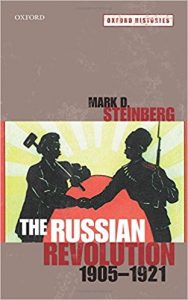A New History of the Russian Revolution

Mark D. Steinberg, The Russian Revolution, 1905-1921 (Oxford: Oxford University Press, 2017). 388.

Review by Jacob Bruggeman
Mark D. Steinberg’s new book, The Russian Revolution, 1905-1921, is a history of the Russian Revolution as an effusion of experiences. The years of the revolution, delineated by Steinberg as 1905 – 1921, compose a period of multi-national and cross-class experimentations, in both political thought and governments, with ideas of freedom, how to achieve it, and the consequences of trying to do so.
Indeed, Steinberg’s explicit aim for his book’s first part, “Documents and Stories,” is to enter the ““springtime of freedom” in 1917,” and to explore “the meaning of “freedom”” (5). To achieve this, Steinberg exhumes numerous “voices”, providing multiple perspectives, from the tumult and uncertainty in 1917. In bringing these myriad voices to the fore, Steinberg imagines that “we can walk through the streets during these first months of revolution,” thus allowing readers to “ask people what they meant by that great, inclusive, and yet vague idea that everyone insisted defined the revolution: “freedom”” (15).
Freedom’s relationship to the revolution is explored through the book’s other two parts, “Histories” and “Places and People,” and both titles allude to different lenses through which Steinberg examines his period of the Russian revolution. Through these lenses, readers look at snapshots within Steinberg’s periodization of the revolution. In “Histories,” Steinberg reconstructs a Russia in the period from 1905 through the outbreak of World War I in 1914, and therein discusses a “bacchanalia” of sex and popular violence, how the press viewed the “darkness” of “these times,” and the portents of World War I (56-63); in part three, “Places and People,” Steinberg pivots back to a telling of the revolution through the subjectivities of human persons—to analyses of the self, or lichnost’ in Russian—as engines of history moving through time, and how “people understood, lived, and practiced “freedom”” (5).
Throughout this three-pronged analysis of the revolution, Steinberg maintains his goal of exploring different meanings of freedom, and in so doing investigates still-important questions about human fulfilment and needs, resistance to power, and truth(s). As he situates these difficult questions in the Russian revolution, Steinberg superimposes the writings of several philosophers—those of Hanna Arendt and Walter Benjamin, and to a lesser extent those of Karl Marx and Friedrich Engels—on the events of 1917. Drawing from Arendt and Benjamin, Steinberg interprets the Russian revolution as an example of humanity’s proclivity to ““catastrophe,”” or at least a natural tip of “the scales of reality … in favor of disaster” (17). Nevertheless, Steinberg sees revolutions, and particularly that of Russia, as “one of human history’s strongest expressions of […] desire, vision, and possibility,” a collective act that, in Walter Benjamin’s words, ““blast[s] open the continuum of history”” (17). In this view, Steinberg argues that the Russian revolution (and revolutions throughout human history) may be interpreted as a “leap in the open air of history,” a rejection of the linearity of time and open embrace of “a sudden new beginning,” of history as “radical possibility” (17-23).
On the whole, Steinberg’s story of the revolution attempts to reorient scholarship and popular perceptions of the revolution to a more nuanced, perhaps appreciative, reading of the ‘leap’ taken by Russians in 1917. But Steinberg complicates the notion of a single ‘leap’, instead suggesting that 1917 was conglomeration of ‘leaps’, for each revolutionary faction—indeed each individual—foresaw different outcomes of 1917’s ‘radical possibility’. Consequently, Steinberg questions the sanctity of singular narratives of the revolution, and history in general. In an era when many believe that society “must venture beyond the life as it is to create life as it ought to be,” Steinberg’s The Russian Revolution is an inspiration and warning both. While many scholars focus on the fall, how the ‘leap’ is landed, Steinberg suggests that, especially in an era in which a ‘leap’ seems possible, more attention ought to be paid to the process of the ‘leap’: the various energies built up before it, the multiplicity of muscles that push off the ground, and the outpouring of thought while suspended in air.
Jacob Bruggeman is a third-year history major at Miami.